Sciences at Southern Get Dynamic New Home; Local Companies Help Along the Way
/Students attending Southern Connecticut State University this semester are the first to use the campus’ new Academic Science & Laboratory Building, opened this fall, with local companies playing an integral role from design and construction to providing scientific equipment for the new facility.
Officials say Southern's ongoing expansion of its science programs has been greatly enhanced with the construction of the 103,608-square-foot, four-level academic and laboratory science building. Situated adjacent to Jennings Hall, the existing home for the sciences on the New Haven campus, the new building extends the university’s capacity to educate more students in the STEM disciplines – science, technology, engineering and mathematics.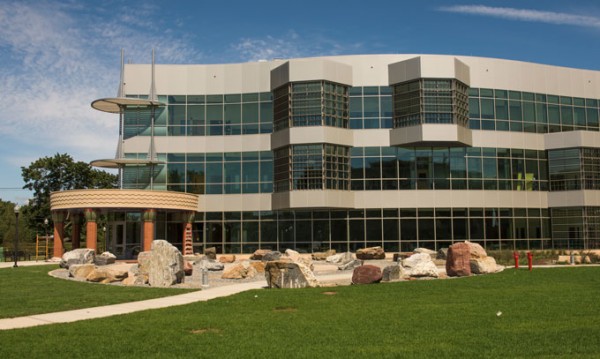
The new science building also features a high-performance computing lab for research in theoretical science, bioinformatics, and computer science, two aquaria, and six rooftop telescope stations. A collaboration between Southern and PerkinElmer, based in Massachusetts and with offices in Shelton, has also provided a boost. Equipment includes several analytical instruments to improve research capabilities and provide students with opportunities to do cutting-edge work.
Configured in the shape of an “L,” the new building works in concert with two pre-existing science buildings — Jennings and Morrill halls — to enclose a new “science enclave.” With very visible scientific displays and instrumentation inside and outside the building, the new center has quickly assumed a symbolic as well as actual role for the sciences on campus.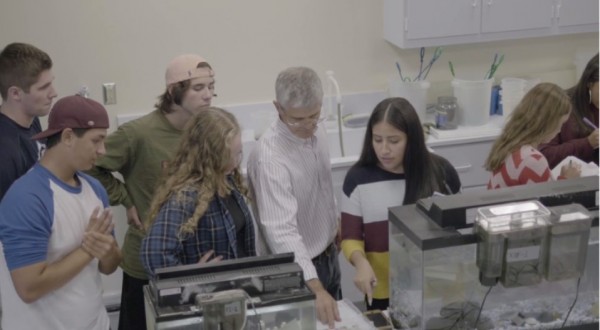
Embracing innovative sustainable design, it houses teaching and research training laboratories for nanotechnology, physics and optics, the earth sciences, the environmental sciences, cancer research, astronomy, molecular biology and chemistry.
“Built to the latest standards in sustainability, this signature building will truly enhance our ability to foster the next generation of Connecticut scientists,” Southern president Mary A. Papazian said at last month’s ribbon-cutting ceremony.
The Werth Center for Marine and Coastal Studies –named in honor of the Werth family following a $3 million gift from the Werth Family Foundation -- is housed on the second floor. The center will have several new labs, including an analytic lab (where mercury levels can be determined) and a sediment coastal science lab (where levels of sediment can be tested).
The Center for Nanotechnology will be located on the ground floor, where the laboratory space is designed to isolate the building's vibrations -- considered important when dealing with microscopic materials. A saltwater aquaria room with a touch tank is featured in the new building, providing a “centerpiece of outreach to area schools and the community.”
 The building includes expanded wings for Earth Science, Environmental Science, Molecular Biology, Chemistry, and Physics teaching and research laboratories. There are scientific displays throughout, illustrating the research interests of faculty and the students, including a replica of a nanotube — a focal point in the center of the building. Rain water collection, which is being used to water the science quad and faculty garden was also integrated into the design. Designed for LEED Silver certification, many sustainable design features can be seen throughout the building’s footprint.
The building includes expanded wings for Earth Science, Environmental Science, Molecular Biology, Chemistry, and Physics teaching and research laboratories. There are scientific displays throughout, illustrating the research interests of faculty and the students, including a replica of a nanotube — a focal point in the center of the building. Rain water collection, which is being used to water the science quad and faculty garden was also integrated into the design. Designed for LEED Silver certification, many sustainable design features can be seen throughout the building’s footprint.
PerkinElmer delivered instruments and services “designed to help improve human and environmental health,” Christine Broadbridge, SCSU’s director of science, technology, engineering and math initiatives, recently told the Fairfield County Business Journal. “At Southern, we are proud to have a strong relationship with PerkinElmer, an important leader of business and science here in Connecticut.”
Ted Gresik, senior director of PerkinElmer, expressed his appreciation in being given the opportunity to work with Southern and accelerating its science through access to its innovative technologies. At the ribbon-cutting, he said “We recognize the opportunity for Southern Connecticut State University and Perkin Elmer to work together on research, and technology initiatives toward developing programs where students can acquire a diverse set of scientific and technical skills which will facilitate a transition to career opportunities within the science industry.”
 Plans for the new Academic Science & Laboratory Building at Southern began back in 2007 with a comprehensive 10-year capital improvement plan, dubbed CSUS 2020, for upgrading the four institutions of the Connecticut State University System. Approved by the state legislature and signed into law by Gov. M. Jodi Rell, the plan was developed during the administration of Chancellor David G. Carter. It included upgrades and repairs to existing facilities, as well as construction of a new Visual & Performing Arts Center at Western Connecticut State University, which opened in September 2014, a new academic and classroom building at Central Connecticut State University, which opened two years ago, and a Fine Arts Instructional Center at Eastern Connecticut State University, scheduled to open early next year.
Plans for the new Academic Science & Laboratory Building at Southern began back in 2007 with a comprehensive 10-year capital improvement plan, dubbed CSUS 2020, for upgrading the four institutions of the Connecticut State University System. Approved by the state legislature and signed into law by Gov. M. Jodi Rell, the plan was developed during the administration of Chancellor David G. Carter. It included upgrades and repairs to existing facilities, as well as construction of a new Visual & Performing Arts Center at Western Connecticut State University, which opened in September 2014, a new academic and classroom building at Central Connecticut State University, which opened two years ago, and a Fine Arts Instructional Center at Eastern Connecticut State University, scheduled to open early next year.
The Science Building at Southern was designed by Centerbrook Architect and Planners of Centerbrook, CT, with construction by FIP Construction of Farmington. (see video about the Academic Science & Laboratory Building)



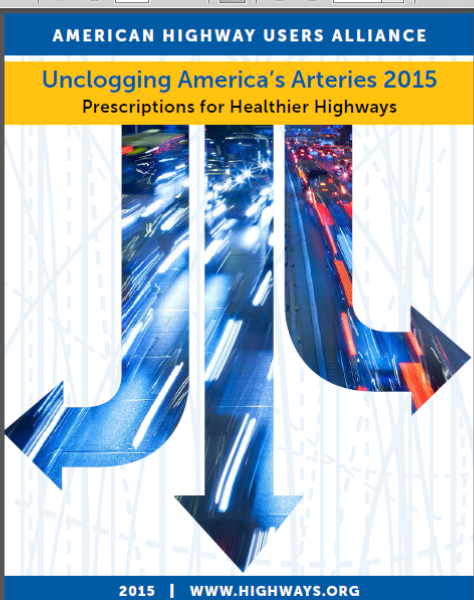
 The work, which has yet to be funded, is likely to include moving or eliminating some exits and entrances – and possibly adding others in new locations - to improve traffic flow. Cost estimates range from $4 billion to $12 billion, depending on the option selected. Upcoming public meetings are to be held in East Hartford on Dec. 2 and Hartford on Dec. 10.
The work, which has yet to be funded, is likely to include moving or eliminating some exits and entrances – and possibly adding others in new locations - to improve traffic flow. Cost estimates range from $4 billion to $12 billion, depending on the option selected. Upcoming public meetings are to be held in East Hartford on Dec. 2 and Hartford on Dec. 10.






 “Key and First Niagara are a powerful combination, driven by a shared commitment to the clients and to the communities we serve,” KeyCorp Chairman and CEO Beth Mooney said. “This transformational opportunity will bring compelling and complementary capabilities to our shared three million clients, while driving meaningful synergies and enhancing shareholder value. KeyBank and First Niagara both have values-based cultures and a long-term commitment to and experience with the region.”
“Key and First Niagara are a powerful combination, driven by a shared commitment to the clients and to the communities we serve,” KeyCorp Chairman and CEO Beth Mooney said. “This transformational opportunity will bring compelling and complementary capabilities to our shared three million clients, while driving meaningful synergies and enhancing shareholder value. KeyBank and First Niagara both have values-based cultures and a long-term commitment to and experience with the region.”

 The celebration also included a tour of the lab’s research and development projects. Employees from Alstom’s nearby Windsor, campus, where the
The celebration also included a tour of the lab’s research and development projects. Employees from Alstom’s nearby Windsor, campus, where the  company employs more than 1,000 people, also attended tours of the new facility.
company employs more than 1,000 people, also attended tours of the new facility.


 In
In  stitutions, particularly in low income communities and to people who lack access to financing. By offering tailored resources and innovative programs that invest federal dollars alongside private sector capital, the CDFI Fund serves mission-driven financial institutions that take a market-based approach to supporting economically disadvantaged communities. The institutions to receive CDFI Certification in Connecticut are in the state’s major cities:
stitutions, particularly in low income communities and to people who lack access to financing. By offering tailored resources and innovative programs that invest federal dollars alongside private sector capital, the CDFI Fund serves mission-driven financial institutions that take a market-based approach to supporting economically disadvantaged communities. The institutions to receive CDFI Certification in Connecticut are in the state’s major cities:
 Capital Fund facilitates the flow of capital and expertise into housing and economic developments that “benefit low and moderate income people in the Greater Bridgeport Area.” It was formed in 2005 from the merger of two loans funds.
Capital Fund facilitates the flow of capital and expertise into housing and economic developments that “benefit low and moderate income people in the Greater Bridgeport Area.” It was formed in 2005 from the merger of two loans funds. he Middlesex Credit Union, Seasons Federal Credit Union was renamed in 2006 after expanding into New Haven County. Over the years, the credit union has “broadened its services beyond simple share savings and small loans to meet the increasingly diverse financial needs of its growing membership.”
he Middlesex Credit Union, Seasons Federal Credit Union was renamed in 2006 after expanding into New Haven County. Over the years, the credit union has “broadened its services beyond simple share savings and small loans to meet the increasingly diverse financial needs of its growing membership.” such as credit history, language, cultural differences, financial literacy, or lack of economic assets--that can isolate people from the financial mainstream. As the Fund’s slogan indicates, “We Finance Hope.”
such as credit history, language, cultural differences, financial literacy, or lack of economic assets--that can isolate people from the financial mainstream. As the Fund’s slogan indicates, “We Finance Hope.”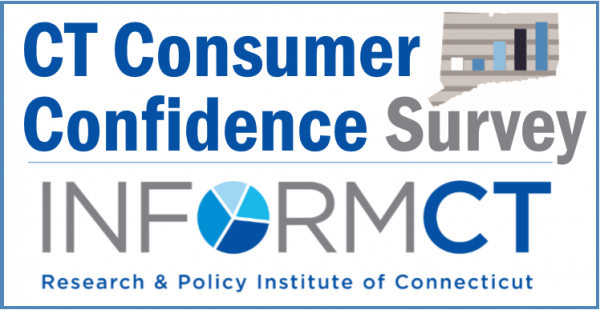

 ncing or purchasing a home in the next six months dropped from by one-third, from 18 percent in the first quarter of the year to 12 percent by the end of the third quarter. Interestingly, buying a car appears immune to economic outlook – the percentage who anticipate that purchase in the next six months has been nearly identical in each quarterly survey this year.
ncing or purchasing a home in the next six months dropped from by one-third, from 18 percent in the first quarter of the year to 12 percent by the end of the third quarter. Interestingly, buying a car appears immune to economic outlook – the percentage who anticipate that purchase in the next six months has been nearly identical in each quarterly survey this year.


 The company, and impacted automakers, are making parts necessary to accomplish repairs available in regions of the country with humid climates first, because humidity has been said to increase the risk of air bag rupture. Connecticut residents, living in a region not known for its humidity, are not a priority for the repair, and continue to wait for word when repairs for their recalled vehicles can be made.
The company, and impacted automakers, are making parts necessary to accomplish repairs available in regions of the country with humid climates first, because humidity has been said to increase the risk of air bag rupture. Connecticut residents, living in a region not known for its humidity, are not a priority for the repair, and continue to wait for word when repairs for their recalled vehicles can be made.



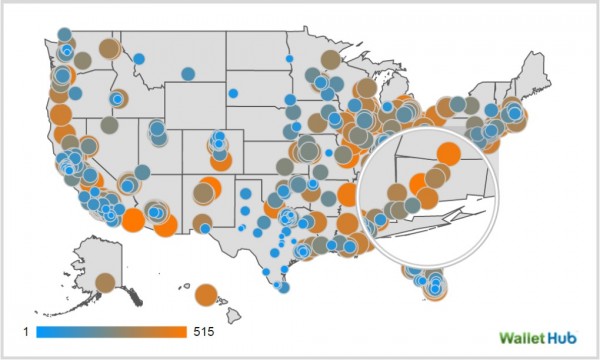 Joan Fitzgerald, Professor of Public Policy and Urban Affairs at Northeastern University, told WalletHub: “It is not an accident that many of the fastest growing cities have thriving high tech and biotech sectors along with financial services and usually a strong health care sector. But another priority has to be balance. In many cities, manufacturing loses out over other uses.”
Joan Fitzgerald, Professor of Public Policy and Urban Affairs at Northeastern University, told WalletHub: “It is not an accident that many of the fastest growing cities have thriving high tech and biotech sectors along with financial services and usually a strong health care sector. But another priority has to be balance. In many cities, manufacturing loses out over other uses.”


























